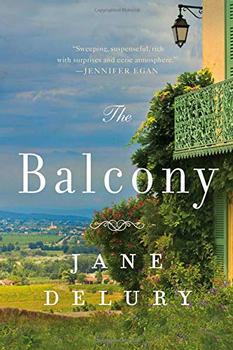Summary | Excerpt | Reviews | Beyond the Book | Read-Alikes | Genres & Themes | Author Bio

This article relates to The Balcony
Although only a small portion of The Balcony takes place during World War II, its effects on Benneville and the estate affect the arc of the story and its characters. At the beginning of the novel, Brigitte, the au pair, learns that the current owner of the estate, Olga, had Jewish parents who moved there during the Occupation. While they thought they would be safe in the country, they were arrested by the Gestapo and sent to Drancy.
 Drancy Internment Camp served as a concentration camp in occupied France, located in Drancy, a northern suburb of Paris. Initially, the Germans seized the public housing structures in 1941. When French police began arresting Jews that summer, Drancy housed them until March of 1942 when the detainees were transported east to death camps like Auschwitz.
Drancy Internment Camp served as a concentration camp in occupied France, located in Drancy, a northern suburb of Paris. Initially, the Germans seized the public housing structures in 1941. When French police began arresting Jews that summer, Drancy housed them until March of 1942 when the detainees were transported east to death camps like Auschwitz.
When the Germans first appropriated Drancy as an internment camp, French police primarily operated it. In July of 1943, SS Officer Alois Brunner, tasked with the French extermination of the Jews, took command. Drancy's internees experienced harsh living conditions while imprisoned. The U-shaped public housing structure, meant to hold 700 people, held 7,000 prisoners at its peak. In addition, the building was not fully complete making for drafty and unsanitary conditions. Hunger was ever-present with meager daily rations.
 Jews made up most of Drancy's detainees although a few were members of the French resistance, homosexuals or ethnicities deemed "undesirable." In the beginning, most internees were foreign Jews who had sought asylum in France from Germany, Poland and later, Austria. Once the round-up of French Jews began, most were sent to Drancy and eventually constituted one-third of its prisoners. Drancy's inhabitants also included 4,000 children ages 2-12 separated from their parents after the Vel d'Hiv roundup in Paris. Notable Drancy detainees included poet Max Jacob, and choreographer René Blum who were put to death at Auschwitz and philosopher Tristan Bernard, who was released in 1943 and died in Paris four years later.
Jews made up most of Drancy's detainees although a few were members of the French resistance, homosexuals or ethnicities deemed "undesirable." In the beginning, most internees were foreign Jews who had sought asylum in France from Germany, Poland and later, Austria. Once the round-up of French Jews began, most were sent to Drancy and eventually constituted one-third of its prisoners. Drancy's inhabitants also included 4,000 children ages 2-12 separated from their parents after the Vel d'Hiv roundup in Paris. Notable Drancy detainees included poet Max Jacob, and choreographer René Blum who were put to death at Auschwitz and philosopher Tristan Bernard, who was released in 1943 and died in Paris four years later.
On July 31, 1944, the final transport from Drancy left France. As Allied forces closed in, the German authorities burned all documents and fled. The camp then came under the command of Swedish Consul-General Raoul Nordling, who ordered the French Red Cross to care for the remaining 1,500 people left. The buildings became inhabited as public housing once again in 1948.
In 2012, then President Francois Hollande, dedicated a new Holocaust memorial in Drancy. Separate from (but complementary to) the museum in Paris, The Shoal Museum in Drancy is a five-story structure across from the buildings used as Drancy Internment Camp and includes a conference room, camp documents and a permanent exhibit. According to the memorial's website, Swiss architect Roger Diener designed the building to be "sober and dignified."
As part of President Hollande's dedication speech, he acknowledged and addressed France's role in working with the Nazis to arrest and deport Jews to death camps. "Our work is no longer about establishing the truth," he said." Today our work is to transmit. That is the spirit of this memorial. Transmission: there resides the future of remembering."
Picture of the Drancy Internment Camp from German Federal Archive
Picture of the Drancy wagon now on the grounds of The Shoal Museum in Drancy by Dominique Natanson
Filed under People, Eras & Events
![]() This "beyond the book article" relates to The Balcony. It originally ran in April 2018 and has been updated for the
March 2019 paperback edition.
Go to magazine.
This "beyond the book article" relates to The Balcony. It originally ran in April 2018 and has been updated for the
March 2019 paperback edition.
Go to magazine.
Your guide toexceptional books
BookBrowse seeks out and recommends the best in contemporary fiction and nonfiction—books that not only engage and entertain but also deepen our understanding of ourselves and the world around us.